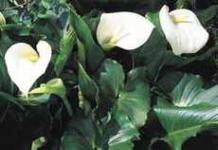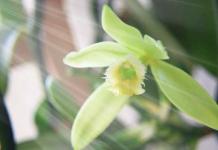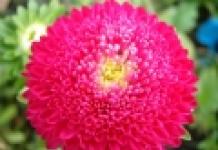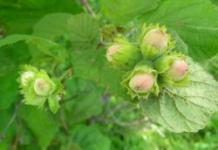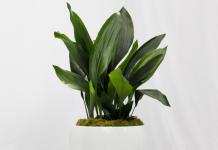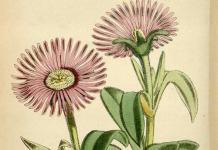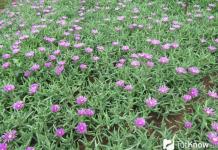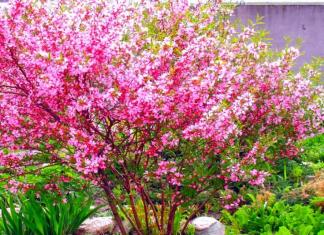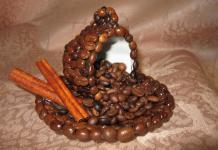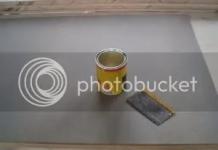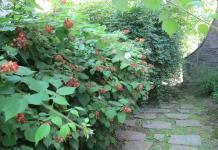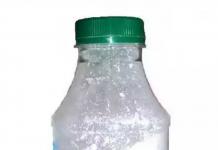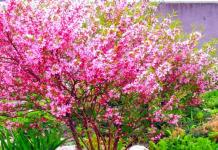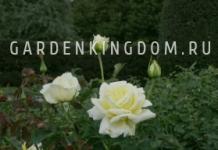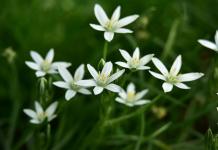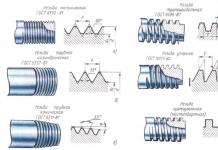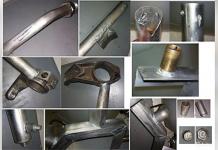The aspidistra plant is a perennial shrub belonging to the asparagus family. Its homeland is the tropical forests of East Asia. In total, there are 8 species of this plant, in the conditions of home maintenance, high aspidistra is more common, it is hardy and unpretentious in care.
Short Description
Aspidistra is a plant 50-60 cm high, it has strong roots, from which leaves grow, there is no stem as such. Aspidistra leaves are shiny, their plates are saturated green, covered with veins, sometimes bent upwards, their length is 60-80 cm, width is about 10 cm.
It produces an aspidistra flower in the form of single bells, based on a root close to the ground, flowering in this plant is quite rare.

This unpretentious and hardy plant, which can exist in places with insufficient lighting and in conditions with low temperatures, has also adapted to poor ecology. The plant grows and develops quite slowly.









Care for aspiridistra
Almost all types of aspidistra do not require special care, freely withstand cold (but not frost) and do not need good lighting. Only species with striped leaves are an exception, they require a lot of light.

The plant is able to adapt to different temperature conditions, in addition to cold, it easily perceives heat, if the room is above 20 degrees Celsius, then it is recommended to spray the leaves with water at room temperature.

Simple care at home has made it possible for this flower to spread around the world in less than 100 years.

How to water properly
Watering a flower is quite simple. It is necessary to monitor the soil, as soon as the top layer begins to be dry, this is a sign that the plant can be watered. On average, in the warm season, it is watered 2-3 times a week, and in winter it is enough once, or even less often.

The choice of land for aspidistra
The plant is unpretentious in care, it does not need special soil, for its planting, you can take ordinary soil from a flower bed. But if you want aspidistra to grow faster, then you can make more nutritious soil, for this, you need to take 1 part of sand, 2 parts of soddy soil, 2 parts of deciduous soil, 2 parts of humus. It is better to plant young specimens in such soil, for better development and rooting.























Aspidistra is a genus of plants of the asparagus family, with 8 species. Belongs to the order asparagus, class monocots. This is a perennial, stemless herbaceous culture with a developed root system and a leaf height of about 55 cm. In room conditions, high aspidistra has become widespread. Differs in very slow growth.
Aspidistra belongs to the most ancient cultures. Its homeland is the tropical lands of East Asia. In writings dating back to the Wei era, there are descriptions of the plant. Prefers shady places. Long evolution gave the culture increased endurance combined with high adaptability, for which the aspidistra is sometimes called the cast-iron flower. The Iron Lady has another name - "snake pointer" ("asp pointer", - "flower", which shows a creeping snake). Under this nickname, she is known to the general public due to the ability of the leaves to sway in contact with the bodies of reptiles. Another name - "Friendly Family", due to the developed root shoots. 
From the point of view of science, "big leaves" are actually shoots. "Real leaves" resemble scales and are needed by aspidistra to ensure the germination of shoots.
Flowering indoors is a rarity. Flowers with a very short peduncle are located on the rhizome, practically on the ground, and do not represent decorative value. They bloom for only one day. In the wild - during the monsoon rains - in January-March. In room conditions, aspidistra can please with flowers in winter, spring or summer.
Master florists often use aspidistra when composing wedding bouquets. Its wide and decorative leaves, which remain attractive for a long time, are often folded into flowering plants that cannot boast of their greenery. Bouquet compositions are used to decorate brides' outfits, festive photos, as well as halls for ceremonial receptions. Special artificial textile ribbons are popular, imitating the texture of an aspidistra leaf.
Prices vary by availability. For example, the price for an aspidistra of the Elatior variety ranges from 2000-3500 rubles.
Types for indoor cultivation
It is believed that the presence of aspidistra in the home interior is a good omen, since the plant adds stamina to character, protects its owner from gossip and helps resist harmful temptations. Like the acaya palm, spathiphyllum or dieffenbachia, it carries exceptionally positive energy.
In the wild, there are approximately 90-100 species of aspidistra.

For the purpose of growing in room conditions, the following varieties of it have become widespread:
| species name | Leaf Features | general description |
| High, Elatior | Dark green glossy large, forming a dense crown, resembling a waterfall. The shape resembles lily of the valley leaves measuring 50 by 15 cm. | The rhizome is serpentine in shape. Flowers crimson or brownish-yellow. The berry contains only one seed. |
| Variegata | The surface is covered with white longitudinal stripes of various widths. | The bush is small, no more than 50 cm. It requires careful care. |
| Milky Way | Large dark green, covered with white dots and spots without a definite shape. | This is one of the most famous variants of the variegated (variegated) aspidistra. Drought and low temperature resistant. Flowering occurs in late winter - early spring. Flowers solitary. |
| Amanogawa | In the center are white dots, the edges are crowned with wide yellow stripes. | Derived from the Milky Way aspidistra. |
| Fuji no Mine (“Snow Cup”) | Broad, dark green, with lighter stripes on the sides. The top is decorated with a white “cap”, which, according to Japanese breeders, resembles the top of the legendary Mount Fuji. | Large variety. White tips appear only in an adult plant. |
| Ginga Giant | Large, spotty. | The most shade-loving variety. Frost-resistant. Withstands temperatures down to -10°C. |
| broad-leaved | It has longitudinal wide white stripes. | Delicate culture. Blooms from February to March. |
| yellow hammer | Greens are decorated with an abundance of creamy yellow spots. | This is the ugliest look. |
| oblancefoliya | Narrow green, width does not exceed 3 cm. | The plant is not tall, reaching no more than 60 cm. It blooms in early spring. The flowers are small, red. |
| Star of Nagano | Decorated with small yellow specks-stars. | Gained fame for its ability to bloom. It blooms brightly and profusely, the flowers are reddish. The usual time is February. |
| Spider Man | Small, no spots. | In all its appearance it resembles a spider. Petioles are cobwebs, and purple flowers look like representatives of arachnids. |
| giant splatter | A feature is the presence of large greenish-yellow spots. | Released in Taiwan. |
| snow white crown | Long dark green with wide white stripes | The pattern appears by the 3rd year of life. |
| Morning sun | As if “shaded” with narrow whitish-cream rays. | The decorativeness of the plant increases with age. Needs a large pot to grow. |
| Sichuan | Green, single color. | Blooms from January to March. Inflorescences resemble a bell of 6 petals. |
| Guangzhou | Dark green with yellow spots up to 20 cm long. | Blooms in May. The buds are purple or violet. |
| large-flowered | Smooth, elliptical with contrasting spots. | The flowers are purple. Blooms in mid-summer, rarely. The diameter of the opened flower can be 5 cm. |
| Attenuata | Reverse egg-shaped, dark green with slight patches. | Creeping rhizome. It does not require special care. A small (3 cm) purple flower may appear in early summer. |

room care
Home care involves following a few simple rules:
- The best place is in the back of the room.
- Acceptable temperature - + 18 ... + 25 ° С.
- Aspidistra does not like drafts.
- Withering and darkening leaves indicate hypothermia or sharp fluctuations in air temperature.
- The plant does not tolerate dryness and excess moisture. It is believed that "it is better to underfill than to fill."
- It should be watered regularly using softened water (with a reduced content of chloride and calcium ions).
- It is useful to spray with clean water. Dust should be removed with a soft cloth or sponge.
- The best time to feed is from April to October. Universal complex fertilizers have proven themselves well.
Seasonal plant care
| Season | Location/Lighting/Humidification | Temperature / Watering | top dressing |
| Winter | Prefers shade, feels great away from windows, better - on the north side. If light spots appear on the leaves, then the plant needs sunlight, the lighting level needs to be increased. Wipe the leaves as they get dirty. 1 spray per week. |
+16°С. 1 time per week. |
Not produced. |
| Spring | +18°С. 1 time in 6 days. |
Depending on the variety. From 1 time in 2-3 weeks to 1 time in 6-7 weeks. Mineral fertilizers with a high nitrogen content are used. | |
| Summer | +20°С …+22°С. 1 time in 5 days. |
||
| Autumn | +18°С. 1 time in 6 days. |
Not produced. |
Pot selection, soil, planting, transplanting
Aspidistra loves light, fertile, slightly acidic or neutral soil. Deciduous soil with an admixture of peat has such properties. The optimal composition of the soil can be made independently by mixing river sand, turf, leaf soil and manure humus in a ratio of 1:2:2:2.
Due to the fact that the plant does not tolerate transplantation well, as it has delicate roots, it is recommended to do it only if necessary. When the plant pot really gets small. The recommended time is mid-spring. It is better to transplant only young plants, without clearing the roots of the old soil. The new flowerpot should exceed the old one in diameter by 4-5 hours. It is better to transplant no more than once every 3-4 years, placing a thick layer of drainage on the bottom.
Step by step transplant looks like this:
- A layer of soil is poured into the pot for drainage.
- In order to avoid injury to the roots, the plant is transplanted by transshipment, it is not recommended to destroy the earthen ball.
- After the flower is covered with soil. Accidentally damaged roots are sprinkled with charcoal.
- The roots should not be buried, the basal neck should be left on the surface.
It is better to put a pot with a plant on a stand, not very high, so as not to allow the earth and roots to cool. Sometimes baskets are made for these purposes.
pruning
The plant needs periodic pruning of old and damaged leaves in order to prevent diseases and maintain a healthy appearance. The leaves are cut off at the very rhizome.
Pruning improves the general condition of the aspidistra, keeps it attractive and stimulates the growth of new leaves.
reproduction
Aspidistra reproduces by seeds, division of the bush and through leaves:
- Sedentary small flowers in the form of pink or purple bells are located singly above the ground. Their diameter does not exceed 2.5 cm. After pollination, rounded fruits are formed, which, after full ripening, give seeds. The seed can be used to grow the plant later. Aspidista with this breeding option will grow for many years. The method is used to obtain new varieties.
- Dividing a bush is the most convenient way of reproduction. To do this, in March, the rhizome is cut into pieces by rosette, with 3-5 leaves on each rosette. To avoid rotting, the sections are sprinkled with charcoal, after which they are planted in the soil in small pots, which are recommended to be moderately watered at a temperature of + 18- + 20 ° C in the first week. A bush with a number of leaves less than 8 should not be propagated by division.
- To use the leaf as a means of propagation, it must be cut, removing the petiole until compacted at the base. The base of the sheet plate is placed in a jar of water, covered with a film and left in a warm, bright place. After about 12-14 days, white roots appear on the leaf. If it has begun to rot, but there are no roots yet, it is necessary to cut off the rotten part, replace the water and repeat the procedure. The appearance of roots can be accelerated by adding a growth stimulant to the water. After that, the leaf can be planted in the soil, covering it with a transparent glass.
Mistakes in care, diseases, pests
| Problem | Causes | Manifestations | Solutions |
| root rot | Excess moisture, activation of the pathogen fungus. | Wilting and yellowing of leaves. The appearance of dark brown spots and white fluffy plaque on the rhizome. | Removal of diseased roots, treatment of “wounds” with ash, reduction of irrigation regime, use of soil drainage. |
| Red gossamer mite |
Lack of moisture, attack by insect pests. | Browning of the leaves, the appearance of pale spots and cobwebs on the back of the leaves. | Weekly spraying with soapy water or insecticides, scale insects can be harvested by hand (adult scale insects have increased resistance to insecticides). Increase the frequency of watering. |
| Palm scale insects | Yellowing and falling of the leaves, the appearance of small insects on them, as well as brown spots on the underside along the veins. | ||
| Non-infectious chlorosis (disease) |
Irrigation with poor quality water. | The leaves are starting to turn yellow. The green color loses its brightness and fades. Leaf turgor is preserved. | Top dressing with complex fertilizers and watering with clean water. |
| infectious chlorosis | Damage to a plant by an infectious agent. | Rapid yellowing of leaves. | The disease is not cured. The plant is destroyed. |
| sunburn | Exposure to direct sunlight. | The appearance of brown spots. | Move the plant to a shady spot. |
| Lack of development | Lack of nitrogen fertilizers. | Extremely slow growth. | Application of nitrogen fertilizers to the soil. |
| Water scarcity | Dry air against the background of high temperature in the room. | Reduced torgor, wilting and yellowing of leaves, drying of their tips. | Spraying the plant, changing the frequency of watering. Move to a cooler area. |
| Leaves losing color | Lack of light. | Leaf blanching, loss of their characteristic color. | Increasing the intensity of diffused light illumination. |
| Excess fertilizer. | Selection of fertilizers and frequency of feeding. | ||
| Excess moisture in the soil | Frequent watering | Leaves darken and become lethargic. | Removing excess water from the pan, reducing the frequency of watering. |
| Aphid attack | Insect activation. | Clusters of insects appear on young leaves. The leaves lose their shape and dry out. | Treatment of the plant with insecticides, including preparations containing permethrin. |
| leaf spot | Frequent watering, infection with a pathogen fungus. | The appearance of brown spots on the leaves surrounded by a yellow halo. | Removing diseased leaves, reducing the frequency of watering, the use of fungicidal preparations. |
Medicinal properties, application
The benefits of using aspidistra preparations are determined by the presence of bioactive substances in its juice composition. Alkaloids have bactericidal properties, stimulate blood flow, contributing to the resorption of hematomas.
Medicinal decoctions are used in the treatment of periodontitis, tonsillitis, cystitis, gastrointestinal diseases. The leaves of the plant are recommended to chew on bleeding gums. Juice is able to quickly stop bleeding. It is also used to treat bruising or open wounds.
The use of medicines based on it, in order to avoid harm to health, is recommended to be carried out under the supervision of the attending physician.
Aspidistra belongs to the evergreen stemless perennial herbs of the Asparagus family. The birthplace of this culture is considered to be East and Southeast Asia. The first specimens were discovered and described in the early 19th century.
Photo gallery



Now there are already about 100 varieties of this plant. Most of them are endemic, that is, they grow in a clearly defined area.
Description
Aspidistra is popularly called snake grass, because the scaly curved rhizomes protruding from the ground look like a snake's body. Basal leaves, devoid of stems, grow extremely densely and tightly to each other.
Due to the visual similarity and lack of bulbs, this culture has long been considered a relative of the lily of the valley and. The leaf blades of this flower are leathery, dark green, shiny, but larger and taller than lily of the valley.
How does it bloom?
Aspidistra blooms rarely and sporadically. In room conditions, this happens most often in winter or early spring. Star-shaped axillary small (up to 2.5 cm) sessile purple or lilac flowers appear between the scales directly from the rhizome.
After pollination, a pear-shaped or rounded fruit is formed with a single large seed inside.
Signs and superstitions
A number of signs and superstitions are associated with aspidistra. It is believed that the flower received as a gift strengthens character and tempers willpower, and also helps to overcome despondency and treats depression. A bush growing in the house gives the owner stamina and endurance.
In addition to magical qualities, the beneficial properties of aspidistra are also used. All parts of the plant (rhizomes, flowers and leaves) have healing characteristics.
Decoctions of this herb are used for urolithiasis, cystitis, gastrointestinal pathologies, muscle pain and cramps.
Types of aspidistra with photos and names
As an indoor flower, no more than 6-8 varieties are grown, differing in size, color and crown shape.
High (aspidistra elatior)
Most often in apartments and offices you can see aspidistra elatior (elatior). The plant resembles a lily of the valley in shape, is a dense bush 60-80 cm high, consisting of a large number of wide (6-10 cm) dark green leathery leaves.
At home, several ornamental varieties of this variety are cultivated:
- Variegata. Brilliant juicy green leaf blades are dotted with longitudinal creamy-white stripes of various widths.
- Blume. Smaller plates, monochromatic bright emerald hue. The flowers are yellowish or brown-crimson.
- Milky Way (Milky way). A shrub not exceeding 40-60 cm in height, with elongated dark leaves, which are covered with many small creamy dots and irregularly shaped spots, resembling stars in the sky.
- snowcap. Broadish leaf blades at the rhizome are green, gradually lighten and become almost white towards the ends.
Attenuata (a. attenuata)
The species was first discovered in the forested mountains of Taiwan. The variety belongs to indoor crops. A bush 55-60 cm high with a powerful massive rhizome forming dense curtains.
Leaves with small vague light spots 6-8 cm wide of a noble dark green shade are located on high petioles. Single bell-shaped whitish or pale green flowers appear once a year at the very beginning of summer. Bud diameter is about 3 cm.
Oblancefolia (a. oblanceifolia)
The variety differs from other varieties in the presence of narrow, no more than 3 cm wide leaf plates, the color of which varies from yellow to green (sometimes spotted). Small red star-shaped flowers open in early spring. The height of the bush grows up to 60 cm.
Sichuan (a. sichuanensis)
In the wild, it grows in dense bamboo thickets of China at an altitude of up to 650-1100 m. A plant with a powerful branched rhizome and single erect elliptical or lanceolate leaves, reaching a height of 60-70 cm and a width of up to 6-7 cm.
Dense green monochromatic or spotted plate has well-defined whitish arcuate veins. Dark purple small bell flower blooms in winter.
Home care
Unlike most indoor plants, aspidistra can be placed anywhere in the room. She is extremely unpretentious in care and will feel good even in artificial lighting. The best place in the house for a flower will be the windows of the north or east direction. 
The plant must be protected from direct sunlight, because ugly burn spots will remain on the leaves. Variegated varieties require a little more light, otherwise they lose their attractiveness and decorative effect.
The culture is undemanding to the temperature in the room. In summer, the best indicators are considered to be within + 20 ... + 22 ° С, in the autumn-winter period, the most comfortable air temperature for aspidistra will be about + 15 ... 17 ° С.
Lowering the temperature to + 10 ° C will have a beneficial effect on the plant, as it stimulates the active growth of green mass. The flower does not tolerate heat very well, so if the room is more than + 25 ° C, then the air humidity should be increased by spraying.
Water the plant regularly, but in moderation. The next watering is done only after the top layer of the earth in the planting tank has dried. During the period of active growth, the substrate is moistened 2-3 times a week, in winter 1 time in 7-10 days will be enough. 
Use well-settled water at room temperature. Periodically, it is recommended to spray the leaves and wipe them with a wet cloth or wash in the shower.
Some experienced flower growers practice growing aspidistra in the garden, where it is transplanted for the summer. It is recommended to place the culture separately from other flowers, because a single bush looks more advantageous.
What kind of soil is needed?
The plant is picky about the composition of the soil. Use any ready-made universal soil for indoor crops.
You can prepare the soil mixture yourself from the following components: 
- leafy earth - 1 part;
- coarse river sand - 1 part;
- sod land - 2 parts;
- peat - 1 part;
- humus - 1 part.
Top dressing and fertilizer
To get a beautiful and decorative flower, you need to periodically fertilize. Top dressing is carried out during the growing season (spring and summer) 1 time in 10-14 days. Any universal mineral complexes for decorative and deciduous indoor crops are suitable. In winter, the flower does not need additional nutrition.
Transplant and reproduction
Aspidistra does not grow quickly, so it is transplanted no more than 1 time in 3-4 years. The transplant procedure is carried out in late spring or early summer by transshipment. Carefully remove the earthen ball from the container, trying not to damage the roots.
The flower is propagated by dividing the bush, seeds and rooting of leaf plates.
The simplest method is the division of the rhizome, which is carried out together with the transplant.
To do this, with a sharp tool, the bush is divided into several parts with growth points, and seated in separate pots.
Diseases and pests
Of the insect pests on the aspidistra, one can sometimes find a scale insect and a spider mite.
To combat them, they use a solution of laundry soap and specialized preparations (actellik, akarin, phytoferm, apollo, etc.).
If the plant does not bloom for a long time, then it is necessary to reconsider the conditions of detention. Dark spots that appear on the leaves indicate hypothermia or the presence of a draft. Occasionally, the culture is affected by fungal infections (chlorosis), such a plant must be destroyed.
A powerful, branched rhizome is half hidden underground, and dense leathery leaves in the shape of a sword rush straight up from it vertically upwards. They can reach a length of 60 cm, and up to 15 cm in diameter. Each shoot carries only one leaf, twisted in the form of a funnel at the base.
In cultural floriculture, only the species Aspidistra high is used. It has several varieties with similar characteristics. Differences are limited to leaf color and more stringent requirements for lighting and soil composition.
Plant care is simple, accessible even to beginners. There are no strict restrictions on watering, fertilizing or air humidity. The only thing to be wary of is direct sunlight.
Thanks to its shade tolerance, Aspidistra does an excellent job of decorating dimly lit and indoor spaces. It grows slowly and, although it can reach a decent size, it should be transplanted only as needed, no more than once every 4-5 years.
The medicinal properties of the plant have long been known. Leaves and roots are widely used in classical and folk medicine, pharmacology.
cultivation
The plant is very viable, it is necessary to transplant only if necessary, in winter it reacts extremely painfully to waterlogging of the soil.
Diseases and pests
Spider mite, scale insect.
reproduction
The division of the rhizome.
First steps after purchase
It is not without reason that Aspidistra is said to be one of the most unpretentious and problem-free plants. In order not to be disappointed in expectations, you need to carefully examine it before purchasing it in the store. Preference is given to the plant with the most leaves. The presence of flowers serves as a clear indicator of health and proper development.
It makes sense to refrain from buying if the tips of the leaves are split in the plant. Each transplant is a serious "stress" for Aspidistra. Better not disturb her unnecessarily.
Success Secrets
Aspidistra is a very undemanding plant. But to demonstrate all the advantages, even for her, good care is important. It is not necessary to make efforts to create special conditions for humidity and air temperature in the apartment. With lighting, too, there will not be any particular problems, the main thing is to protect from direct sunlight.
Plants with solid colored leaves can even do just fine without natural light. When watering, it is important to prevent waterlogging or drying out of the earthen coma, and settled water should also be used.
Possible difficulties
Spots on the leaves
Reasons: 1) being in direct sunlight, 2) hypothermia, 3) too abundant or insufficient watering.
Yellowing leaves
Causes: 1) waterlogging of the soil, 2) rotting of the roots.
Aspidistra high- indoor ornamental plant with a height of under 70 cm. Aspidistra high has lanceolate dark green leaves on long petioles.
Every year it produces about 5 leaves. The coloring of aspidistra leaves depends on the size of the pot and the amount of fertilizer applied to the soil. The leaves can even be variegated with a yellow or white pattern. The leaves are usually 30 to 40 cm in size.

Aspidistra is an ornamental flowering plant. Her flowers are purple, inconspicuous, lying right on the ground. Its flowering occurs from the end of winter and throughout the summer period. By the way, the birthplace of these indoor plants is Asia (China and Japan).
In fact, aspidistra is a tall unpretentious plant. We can say that this plant is for extreme conditions and for beginners and completely inexperienced flower growers, a very simple and unpretentious plant in breeding.
Temperature
Throughout the year, it is able to withstand different temperatures in the room.
The most suitable temperature for year-round maintenance of aspidistra is +15 degrees C. For a short time, it can tolerate low temperatures well and even 0 degrees C.
Lighting for high aspidistra
Aspidistra high easily adapts to any difficult conditions, therefore it can be kept anywhere except for those places that are under the direct influence of direct sunlight, as they burn its leaves. For her, partial shade or a place that is well lit by indirect sunlight is better.
Aspidistra high, as already mentioned, is able to tolerate both drafts and rooms with a lot of dust and fairly dry air. Its leaves will shine spectacularly and look very beautiful if you wipe them with a damp cloth from time to time. It is desirable to clean the plant with water from dust. To do this, use warm and clean water.
spraying
If you have a desire, you can spray the plant once a week. It will do him good, but it doesn't have to.
Watering high aspidistra
However, aspidistra likes moderate watering every 3 days throughout the year. Try to water the plant regularly and moderately, without flooding it, but not allowing it to dry out too much.
top dressing
Every month, aspidistra can be pampered with fertilizers for indoor flowers. Feeding should be done in moderate doses. If you exceed the dose of fertilizers, then cracks will appear on its leaves. In this case, feeding should be stopped.
Reproduction of aspidistra

Propagated by division of roots. This is best done in the spring when transplanting the plant. To do this, pull the flower out of the container in which it grows and free its roots from the ground. The rhizome can be easily divided in half or into several parts, but so that each part has at least two leaves and transplant them into different pots.
Transfer
It is advisable to transplant the plant into other pots every 2-3 years, or at least change the soil in pots.
Aspidistra pests
Aphids, mealybugs, spider mites and scale insects can pose a great danger to aspidistra.
Combination with other plants
Remarkably high aspidistra is combined with abundantly flowering tub plants.
We hope that this article will help you grow beautiful and healthy plants that will delight you and your loved ones. Good luck!


